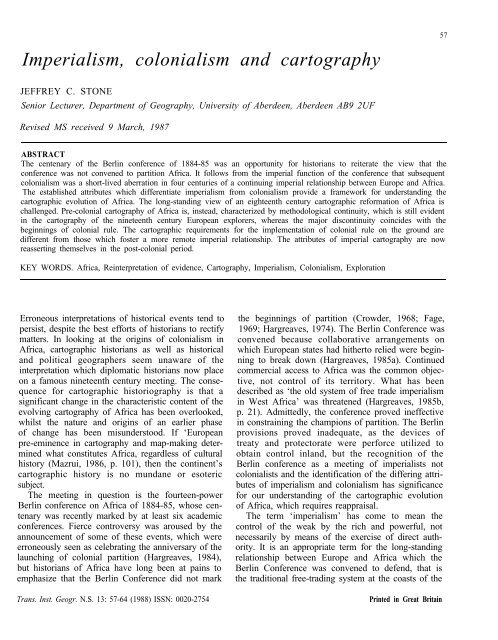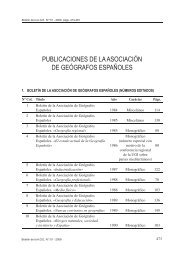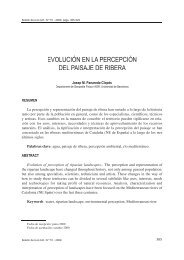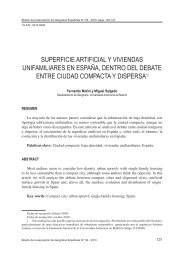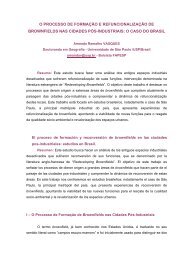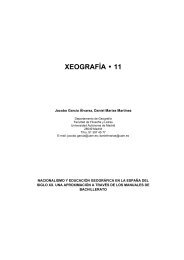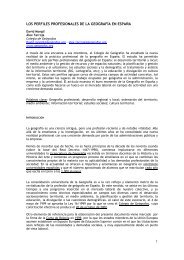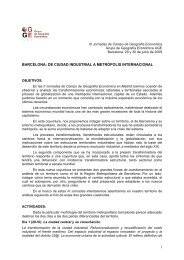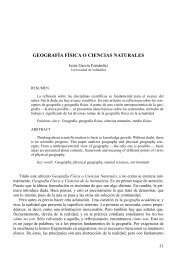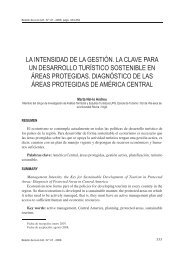Imperialism, colonialism and cartography
Imperialism, colonialism and cartography
Imperialism, colonialism and cartography
Create successful ePaper yourself
Turn your PDF publications into a flip-book with our unique Google optimized e-Paper software.
57<strong>Imperialism</strong>, <strong>colonialism</strong> <strong>and</strong> <strong>cartography</strong>JEFFREY C. STONESenior Lecturer, Department of Geography, University of Aberdeen, Aberdeen AB9 2UFRevised MS received 9 March, 1987ABSTRACTThe centenary of the Berlin conference of 1884-85 was an opportunity for historians to reiterate the view that theconference was not convened to partition Africa. It follows from the imperial function of the conference that subsequent<strong>colonialism</strong> was a short-lived aberration in four centuries of a continuing imperial relationship between Europe <strong>and</strong> Africa.The established attributes which differentiate imperialism from <strong>colonialism</strong> provide a framework for underst<strong>and</strong>ing thecartographic evolution of Africa. The long-st<strong>and</strong>ing view of an eighteenth century cartographic reformation of Africa ischallenged. Pre-colonial <strong>cartography</strong> of Africa is, instead, characterized by methodological continuity, which is still evidentin the <strong>cartography</strong> of the nineteenth century European explorers, whereas the major discontinuity coincides with thebeginnings of colonial rule. The cartographic requirements for the implementation of colonial rule on the ground aredifferent from those which foster a more remote imperial relationship. The attributes of imperial <strong>cartography</strong> are nowreasserting themselves in the post-colonial period.KEY WORDS. Africa, Reinterpretation of evidence, Cartography, <strong>Imperialism</strong>, Colonialism, ExplorationErroneous interpretations of historical events tend topersist, despite the best efforts of historians to rectifymatters. In looking at the origins of <strong>colonialism</strong> inAfrica, cartographic historians as well as historical<strong>and</strong> political geographers seem unaware of theinterpretation which diplomatic historians now placeon a famous nineteenth century meeting. The consequencefor cartographic historiography is that asignificant change in the characteristic content of theevolving <strong>cartography</strong> of Africa has been overlooked,whilst the nature <strong>and</strong> origins of an earlier phaseof change has been misunderstood. If ‘Europeanpre-eminence in <strong>cartography</strong> <strong>and</strong> map-making determinedwhat constitutes Africa, regardless of culturalhistory (Mazrui, 1986, p. 101), then the continent’scartographic history is no mundane or esotericsubject.The meeting in question is the fourteen-powerBerlin conference on Africa of 1884-85, whose centenarywas recently marked by at least six academicconferences. Fierce controversy was aroused by theannouncement of some of these events, which wereerroneously seen as celebrating the anniversary of thelaunching of colonial partition (Hargreaves, 1984),but historians of Africa have long been at pains toemphasize that the Berlin Conference did not markTrans. Inst. Geogr. N.S. 13: 57-64 (1988) ISSN: 0020-2754the beginnings of partition (Crowder, 1968; Fage,1969; Hargreaves, 1974). The Berlin Conference wasconvened because collaborative arrangements onwhich European states had hitherto relied were beginningto break down (Hargreaves, 1985a). Continuedcommercial access to Africa was the common objective,not control of its territory. What has beendescribed as ‘the old system of free trade imperialismin West Africa’ was threatened (Hargreaves, 1985b,p. 21). Admittedly, the conference proved ineffectivein constraining the champions of partition. The Berlinprovisions proved inadequate, as the devices oftreaty <strong>and</strong> protectorate were perforce utilized toobtain control inl<strong>and</strong>, but the recognition of theBerlin conference as a meeting of imperialists notcolonialists <strong>and</strong> the identification of the differing attributesof imperialism <strong>and</strong> <strong>colonialism</strong> has significancefor our underst<strong>and</strong>ing of the cartographic evolutionof Africa, which requires reappraisal.The term ‘imperialism’ has come to mean thecontrol of the weak by the rich <strong>and</strong> powerful, notnecessarily by means of the exercise of direct authority.It is an appropriate term for the long-st<strong>and</strong>ingrelationship between Europe <strong>and</strong> Africa which theBerlin Conference was convened to defend, that isthe traditional free-trading system at the coasts of thePrinted in Great Britain
58 JEFFREY C. STONEcontinent. The freedom was for Europeans to competefor trade, not for Africans to obstruct it (Hargreaves,1984) <strong>and</strong> the imperial relationship was essentiallyinternational in character, being based on mutualityof interests among European powers. The Europeaninternational imperialism which was promoted inBerlin in 1884 is equally evident in the founding ofthe International African Association at the BrusselsGeographical Conference in 1876 (Bridges, 1980) <strong>and</strong>indeed it is a relationship which can be traced backthrough at least four centuries. By contrast, the periodof direct European colonial rule which began neverthelessin the 1890s <strong>and</strong> which is differentiated byparochial European nationalism <strong>and</strong> exclusivity, canbe regarded as an abnormal <strong>and</strong> brief but influentialinterlude in the imperial relationship between Africa<strong>and</strong> Europe. The relatively ephemeral nature of<strong>colonialism</strong> by contrast with imperialism in Africa isemphasized by projecting forward to the postcolonialperiod, for example to the successivenegotiations of the Lome Conventions between theEEC <strong>and</strong> the largely African ACP states. Only tinyresiduals of European <strong>colonialism</strong> remain in Africabut the very long st<strong>and</strong>ing imperial relationship isarguably evolving. European imperialism in Africa ischaracterized by collaborative internationalism <strong>and</strong>historical continuity, whereas <strong>colonialism</strong> was arelatively brief assertion of competitive Europeannationalism. The difference has great significancein underst<strong>and</strong>ing the cartographic evolution ofAfrica.Pre-colonial <strong>cartography</strong> of the interior of Africahas long been seen as dividing into two distinctphases, which are of debatable validity <strong>and</strong> whichobscure the reality of the forces operative. The earlierphase is characterized by its use of Ptolemaic conceptions,particularly for the source of the Nile, <strong>and</strong> isepitomized by the eight-sheet map of Africa of 1564by Gastaldi whose subsequent influence is apparent inthe depictions of Africa by Ortelius (1570), Speed(1627), Blaeu (1642) <strong>and</strong> others. Supposedly, theturning point in the <strong>cartography</strong> of Africa is located inthe ‘Age of Reason’, in the maps of the French school,notably De L’Isle (1700) <strong>and</strong> d’Anville (1727) (Tooley,1969). A scientific approach lead to the removal ofmany legends <strong>and</strong> assumptions by the innovatorswho achieved marked gains in accuracy <strong>and</strong> werefamous for their blank spaces (Lane-Poole, 1950;Klemp, 1968; Tooley, Bricker <strong>and</strong> Crone, 1976;Wallis, 1986) which are allegedly indicative of ascientific attitude of mind. But contemporary wisdomabout the interior of Africa was set aside in favour ofblank spaces as early as 1666 by Vossius (R<strong>and</strong>les,1956), while the Ptolemaic tradition of Africa wasitself replete with blank spaces <strong>and</strong> the use of theword ‘incognita’.Sixteenth <strong>and</strong> seventeenth century <strong>cartography</strong>employed such contemporary sources as were available<strong>and</strong> made significant changes in the depiction ofAfrica (Ouwinga, 1975) in the same way that JamesMacQueen (1856) made substantial changes to themap of Central Africa in the nineteenth century, albeitwith different subject matter <strong>and</strong> quality of data. Justas Almeida was critical of previous depictions ofEthiopia in the seventeenth century (Skelton, 1958),so eighteenth century cartographers reacted to thework of their predecessors, given new sources toh<strong>and</strong>. There is methodological continuity linkingeighteenth century <strong>and</strong> both earlier <strong>and</strong> latercartographers,The critical circumstances for methodological continuityin the mapping of Africa over four centuries bycartographers from several European countries wasmovement of information about Africa within Europe.Certainly, commercial competition meant that thenavigational information of the Dutch, for example,remained secret (Ouwinga, 1975). Nevertheless, originalinformation about Africa did disseminate withinEurope under the commercial impetus of publication.Perhaps the most striking example, which challengesthe conception of the eighteenth century Frenchschool as innovatory in its critical attitudes or itssources, <strong>and</strong> also demonstrates the manner in whichinformation disseminated for commercial gain, is the1665 Portuguese Atlas of Africa by Joao TeixeiraAlbernaz II. The atlas was commissioned by aFrenchman <strong>and</strong> together with other Portuguesesource material, it was used to transform previousdepictions of the Zambezi basin by Jaillot (1678) aFrenchman, by Berry (1680) an Englishman <strong>and</strong> byCoronelli (168.3) a Venetion, in their maps of Africa,before inspiring De L’Isle <strong>and</strong> d’Anville (Cortesão<strong>and</strong> da Mota, 1960). In the past, the commercial <strong>and</strong>strategic divisions within Europe have been stressedin seeking to comprehend the evolving early <strong>cartography</strong>of Africa, but it is the facility with whichPortuguese information disseminated throughoutEurope in the form of the printed map which isstriking. This is underst<strong>and</strong>able, given the essentiallycollaborative nature of European imperialism towardsAfrica.The pre-colonial cartographic depiction of Africarepresents evolution not transformation. The conceptof an eighteenth century reformation derives from
analysis of form, not process, that is from the externalfor of the end product, the change of map content,as ethnographic descriptions <strong>and</strong> perspective drawingsof hills were removed <strong>and</strong> as new informationlead to the ab<strong>and</strong>onment of some long-st<strong>and</strong>ingdelineations of parts of the interior. It is in any case anillusion. Those particular changes in content are notexclusive to the eighteenth century. Furthermore, themanner in which African maps were compiled in theeighteenth century was little altered.The great cartographic watershed for Africa relatesto the replacement of remote imperial influence withdirect colonial authority. In cartographic terms, thetransition is primarily a twentieth century processwhich does not properly include the well knownmaps of the interior of Africa by eighteenth <strong>and</strong>nineteenth century European explorers. There is littleevidence of a direct connection between the explorationsof men such as Livingstone, Speke, Grant <strong>and</strong>Stanley <strong>and</strong> the initiation of <strong>colonialism</strong>. Rather, theconnection is with the ‘unofficial mind’ (Bridges,1982, p. 18) of imperialism which was located in thecommercial middle class of British society, in servicemen<strong>and</strong> officials, businessmen <strong>and</strong> missionaryleaders, <strong>and</strong> in the membership of the African Associationwhich was founded in 1788 <strong>and</strong> quickly becameinvolved in the problem of the source, course <strong>and</strong>termination of the Niger. The maps themselves werebased on instrumental observation which added ascientific dimension to the travellers’ records, animportant ‘civilizing’ clement in legitimizing theEuropean penetration, presence <strong>and</strong> even interferencein Africa in the eyes of the unofficial mind. However,the unofficial scramble for Africa by the commercial<strong>and</strong> service classes was an imperial manifestationto be differentiated from the subsequent <strong>and</strong> notunrelated but more direct intervention by Europeangovernments.An archetypal example of a traveller in the imperialistmould is Alfred Bertr<strong>and</strong>, a Swiss army captainwho was one of a four-man expedition of explorationto north-west Rhodesia in 1895. Bertr<strong>and</strong> was tobecome President of the Geographical Society ofGeneva <strong>and</strong> a Vice-President of the Ninth InternationalGeographical Congress in Geneva. He was amember of ten European geographical societies,mostly honorary, including the Royal GeographicalSociety (Bertr<strong>and</strong>, 1926). The account of his travelsin north-west Rhodesia was published in French(Bertr<strong>and</strong>, 1898) <strong>and</strong> English <strong>and</strong> includes the mapcompiled by the Royal Geographical Society inassociation with the lecture to the Society in 1897 by<strong>Imperialism</strong> <strong>and</strong> <strong>cartography</strong> 59the members of the expedition. As a Swiss national,Bertr<strong>and</strong> could have had little interest in promoting<strong>colonialism</strong> by his native l<strong>and</strong>. As a result of his visitto the Paris Evangelical Missionary Society station atSefula during the expedition, he in fact devoted a greatdeal of time <strong>and</strong> effort throughout the remainingtwenty-seven years of his life to raising financial <strong>and</strong>moral support throughout Europe for the Barotsel<strong>and</strong><strong>and</strong> Basutol<strong>and</strong> missions. The detailed map of ‘TheKingdom of the Marutse’ in his book (Fig. I), with itsmany scientifically authentic latitudinal observationsinscribed on the map <strong>and</strong> its primary concern withphysical features (also mission stations) observed bythe travellers, is appropriate to the imperial (asopposed to colonial) interests which Bertr<strong>and</strong> promotedthroughout Europe so philanthropically <strong>and</strong>vigorously.The cartographic transition from imperialism to<strong>colonialism</strong> tends to lag behind the legal transformation.Maps in the imperial mould continued to bepublished into the colonial period, for example, mapsdepicting the territory under the administration of theBritish South Africa Company published by EdwardStanford between 1895 <strong>and</strong> 1906. Although thesewere compiled with the assistance of a companywho eventually came to govern all of Northern <strong>and</strong>Southern Rhodesia, their function is primarily theprosecution of commercial activities, as shown by themany descriptive entries on the maps, extollingthe farming <strong>and</strong> ranching potential of various parts ofthe country.The great change to maps deriving from the colonialrather than the imperial function is contemporaneouswith first efforts to establish administrationson the ground, usually some short time after theformal proclamation by the colonial authority. Themaps reflect the needs of the nascent administrativesystems, as is exemplified by the first District Officerto be stationed in what was then the Balovale Districtof northern Rhodesia, who refers to his first longtour, as ‘trying to make a census of the people <strong>and</strong> amap of the country’ (Venning, 1955, p. 55). His maphas none of the instrumentally-derived precision ofthe earlier travellers in the region. It is inaccurate(Stone, 1977) <strong>and</strong> its subject matter is predominantlythe location of the local populace. It was a functionaladministrative tool <strong>and</strong> an example of a great manycolonial district maps (Stone, 1982) which locate ruralsettlement in unprecedented detail.The usual reason why professional ColonialSurvey Officers frequently did not compile the mapsnecessary for the imposition of colonial rule was
60 ]EFFREY C. STONEprimarily that where they existed, they were fullyemployed in the pressing task which also derivedfrom the imposition of colonial authority butnecessitated a high order of professional expertise,namely cadastral mapping for the purposes of demarcatingtownships <strong>and</strong> building plots, roads, railways,
alienated l<strong>and</strong>, reserved l<strong>and</strong> <strong>and</strong> all of the otherboundaries that were a part of colonial imposition.The importance of this second type of colonial mapwhich was a product of the change from imperial tocolonial control, IS evident from the necessity forColonial Surveys to resort to unsophisticated compilationtechniques in publishing early topographicseries (Stone, 1984), sometimes employing theamateur work of the District Officer (Fig. 2). Overall,progress on the provision of large scale topographicmap cover in British colonial Africa was slow. Thereason why the Federal Surveys of Rhodesia <strong>and</strong>Nyasal<strong>and</strong> was able to publish such a large number oflarge-scale topographic sheets of Northern <strong>and</strong>Southern Rhodesia during its short life span from1956 to 1964, was in part the paucity of coverageachieved in the previous half century of colonial rule.However, the association of colonial map makingwith cadastral surveys at the expense of topographicsurvey, is nowhere better demonstrated than in SouthAfrica. The method which Potter established in 1657to record rights in l<strong>and</strong> at the Cape (Fisher, 1984,p. 58) IS still in use today, but the country madelittle progress towards the provision of adequatetopographic cover until the reorganization of theTrigonometrical Survey Office in 1936 (Liebenberg,1979), long after the end of colonial rule.A further differentiating factor between imperialism<strong>and</strong> <strong>colonialism</strong> which is supported by the cartographicevidence, is the removal of the internationaldimension with the imposition of colonial rule. This isrecognized, for example, by McGrath (1976), whosestudy of British East Africa specifically excludes theGerman contribution to the mapping of its formerterritory. The nationalistic parochialism of the colonialperiod was carried to its ultimate in the decentralizedadministrative system of former British Africa inwhich territories were treated as separate <strong>and</strong> selfcontainedunits (Jeffries, 1956). In consequence, thereis great variation between the former British territoriesas to the amount <strong>and</strong> type of topographic mappingwhich was carried out. For example, an early start ontopographic survey was made in Ug<strong>and</strong>a by comparisonwith Northern Rhodesia, although Ug<strong>and</strong>a isrenowned for the very early Mailo Survey ofBug<strong>and</strong>a which was an experiment in l<strong>and</strong> settlement<strong>and</strong> exemplifies the pre-eminence of cadastral work inthe colonial period. Each European colonial powerwent its own way in devising, or not devising, itsown programme of surveys <strong>and</strong> each British territorydid likewise.If <strong>colonialism</strong> was a relatively brief aberration in<strong>Imperialism</strong>, <strong>colonialism</strong> <strong>and</strong> <strong>cartography</strong> 61the prolonged <strong>and</strong> otherwise uninterrupted imperialrelationship between Europe <strong>and</strong> Africa, then sufficienttime should have elapsed by now for evidenceof the traits of imperialism to be reassertingthemselves. Debatably, the evidence is present inthe negotiations between the EEC <strong>and</strong> its AfricanAssociates in the context of the Lomé Conventions.Equally contentiously, there is cartographic evidencederiving from the former Directorate of OverseasSurveys (hereafter DOS), a colonial institution inorigin, which had assumed the broader role of anagency for technical aid to overseas governments. AsMcGrath (1983) demonstrates, there is continuity ofpurpose in the relationship between DOS <strong>and</strong> firstlythe then dependencies of the UK, <strong>and</strong> eventually thenewly independent countries, continuity which wasin part a product of the local autonomy of the formerdependencies. Nevertheless, the changed nature ofthe political relationship did bring about change inthe cartographic product, not unrelated to the reformationof British aid policy after the creation of aMinistry of Overseas Development in 1964. In thepost-independence period, the Directorate has ofcourse been obliged to take account of UK governmentpolicy on aid in project selection. It is in thiscontext that changes in product must be seen, as forexample, in carrying out cadastral survey (once thehallmark of colonial surveys <strong>and</strong> now of the surveysof independent governments), most notably insupport of the scheme to resettle African smallholders on farms purchased from Europeans in theHighl<strong>and</strong>s of Kenya; or in the formation of the L<strong>and</strong>Resources Division of DOS in 1964 to produce arange of maps related to l<strong>and</strong> use: or the successful‘joint projects’ of DOS which were specificallydesigned as vehicles for technology transfer. Then,the extensive programmes of large scale topographicmapping which were mounted by the Directorateof Commonwealth Surveys (DCS) throughout largeparts of former British Africa in the years precedingindependence may be seen to have their origins in thegradual reassertion of imperial policy over colonialpolicy, to meet the needs of post-war Britain forreliable sources of primary products in circumstancesof impending political change in Africa. It was thiswriter’s experience that the colonial administrator onthe ground had little need of the topographic coverwhich latterly became available. The significantfeature is not that one type of map is always to beassociated with <strong>colonialism</strong> or with imperialism,(since neither function is static), but that change incartographic usage will occur in the transition from
62 JEFFREY C. STONEthe one political status to the other by virtue ofdiffering functions.Latterly, DOS was devoting a decreasing pro-portion of its effort in Africa to former Britishterritories with programmes of work or trainingprovision for Ethiopia, Liberia, Chad <strong>and</strong> Madagascar
(Directorate of Overseas Surveys, 1985). Not onlywas a more internationalist attitude to Africabecoming apparent, but with the responsibilities ofthe Directorate now transferred to the OrdnanceSurvey’s Overseas Surveys Directorate <strong>and</strong> withmuch overseas work to be transferred to the privatesector (McGrath, 1982) we may see commercial firmsperhaps from several European countries workingunder Ordnance Survey <strong>and</strong> Overseas DevelopmentAgency supervision, thus restoring the commercial<strong>and</strong> international dimensions of European <strong>cartography</strong>in Africa which were associated withseventeenth <strong>and</strong> eighteenth century imperialism.Recent writing (e.g., Griffiths, 1986; Either, 1986)still does not always accept that the delegates tothe Berlin Conference of 1884-85 ‘were not talkingabout partitioning Africa’ (Hargreaves, 1984, p. 17)<strong>and</strong> that it was a last-ditch attempt to sustain Europe’straditionally internationalist approach of commonaccess to Africa. Nevertheless, differentiationbetween the historical continuity of the imperialistmercantile ethic which was still on display in Berlin acentury ago <strong>and</strong> its brief demise in direct colonial ruleprovides a framework for challenging long-st<strong>and</strong>ingInterpretations of pre-colonial cartographic evolution<strong>and</strong> for appreciating the prime characteristics ofcolonial surveys. It also provides a stimulus to furtherwork on colonial <strong>cartography</strong>, in the form of ahypothesis which envisages disparate <strong>and</strong> comparativelyuncoordinated activity across seven shortlivedspheres of European rule. Although brief, it wasan important phase of map making, since it perforceprovided the bases for both the cadastral <strong>and</strong> thetopographic surveys of the independent nations ofAfrica, who are now restored to a more indirect, if notImperial relationship with Europe.<strong>Imperialism</strong>, <strong>colonialism</strong> <strong>and</strong> <strong>cartography</strong> 63


